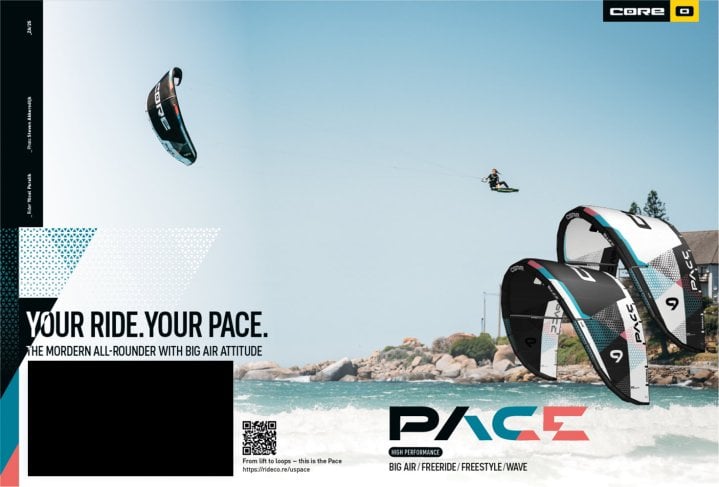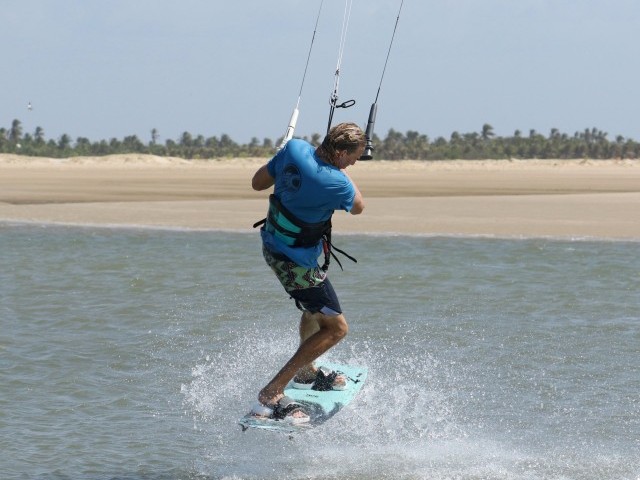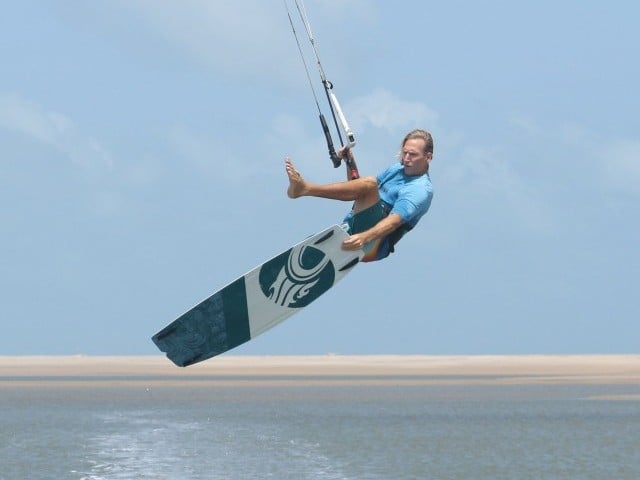
Nose Grab Pop Front Loop Transition
Technique / Intermediate
Introduction
Here’s one for the purists among you, harking back to the days of no de-power, no releases, no leash, no donkey dick and the silkiness of riders like Mr Shinn (although admittedly he’d probably spin the board around a few times for good measure). Pop transitions were all the rage – the pendulum feeling of swinging out under your kite and then floating back in with enough speed to carve straight out was intoxicating. We don’t see enough of these nowadays, and without wanting to get too sentimental here starts out campaign to get them back on the beaches, and our forthright apologies if you’re already an advocate or exponent.
Swiftly let us consider what a pop transition is. The general idea is that contrary to the name you will use your kite, not a lot, to get some lift and float. However you’ll also use your back leg to get up off the water, way before the kite would normally lift you. The idea behind this combination is that you’ll take off whilst still carrying some forward speed way before the kite gets to 12, and therefore by the time you land the kite won’t be too far on the other side of the window and you’ll have plenty of momentum to plane out. Compared to a normal transition where you send the kite sharply but for a short period of time, a pop transition requires a gentle drifting of the kite!
Pic A
Karine has her back hand very much centred on the bar to slow the movement of the kite down and this is on an 11m! She approached with a bit of speed, carved up towards the wind and drifted the kite up by gently steering it. Timing wise, as soon as she feels the first sign of lift on her harness she pops into the move. It’s very tempting to wait and/or let the bar out a touch, but don’t. She’s holding the bar in on the sweet spot, to keep the lift throughout the move and prevent the kite from flying to the edge of the window and you can see that she’s popping pretty hard, extending her back leg completely to get as much height as possible because the kite is merely supporting her whilst lifting her front leg both in anticipation of the grab and the down and round movement of a slow front loop. If Karine rotates too quickly she’ll over rotate as the kite is pulling from behind.
Pic B
The front rotation has started from the impulse of her pop and her shoulders going forward and down. To make sure she gets enough rotation Karine has added in the “Timotei Flick), throwing her head around, looking over her back shoulder. She’s grabbed the nose of the board and pulled it right up to her derriere, bending her front knee. This will help with her rotation as well as adding some style. Also note the position of the kite – because Karine popped early (before the kite got to 12 o’clock) the kite is now above her. She has also pulled the bar in with her very centred hand. Not only does this give her the float and time to complete the move, but if the kite stalls/flares a little bit it will pull downwind, giving momentum for the landing and keeping it away from the powerless edge of the window.
Pic C
Karine stayed in the position of the previous picture until she rotated around enough to spot her landing. During that time she will have swung out under the kite a little bit, but with the bar pulled in and tension on the lines she has now started to swing back in. As she does Karine focuses on her landing spot, releases her grab so that she can get her board down ready for landing, and pulls hard on the bar to dive the kite down for some extra power to pull her out of the move, complete the rotation, and forward onto the new tack.
Pic D
A blink of an eye before landing and you can see that Karine has extended her legs to get the under carriage down, she’s now got both hands on the bar and is diving the kite hard. Most importantly though she’s looking towards the kite and where the pull is coming from. One of the many great things about this move is that because of the pendulum effect you’ll be able to come out with speed and land on a carving edge, so following the kite and it’s pull is vital – don’t try and set up for your usual downwind landing.
Top Tips
We’ll keep it simple and just recap two points. Drift the kite up, keeping the bar on the sweet spot AND go early, as soon as you feel the kite pull on your harness. Your aim is to land this moving the other way without having to loop the kite for power, so finding a balance between speed, drift and timing is the key.
Other than that we would recommend learning this on bigger slower kites, with the sweet spot trimmed further away from you. This combo will be more forgiving than a rapid 7m trimmed for unhooking.
For the sequences we won’t take you through each individual picture but rather focus on what’s important for take off, in flight entertainment and landing!
Sequence 1
This group of picture demonstrates the drift, timing, pop, grab and front loop. Although the pictures are spread out you will actually keep moving forward as you swing out. This is not an up and down elevator transition. Karine drifts the kite from 11 o’clock and as soon as she feels the pressure in her harness pops up hard into her rotation and grab. From that moment onwards she holds her position and keeps the bar pulled in, watching over her shoulder – looking for where she’ll land once she’s facing the other way.
Sequence 2
Here is all about balance. To finish her rotation and land smoothly Karine needs to get the power on by pulling hard on her front hand. She needs to do this as soon as she can see back the other way; otherwise she could over rotate and land facing upwind. This will feel strange at first, as you’ll be pulled back towards the kite whilst your body is still twisted away from it. However have patience as the pull will straighten you up and almost magically set you up for the landing.
Common Problems
Dropping from your rotation into the water whilst you kite flutters down like a leaf to the side. Assuming that you did edge and pop the two most likely reasons for this are 1. Timing and 2. Letting the bar out. Once again make sure you pop before the kite gets to 12, you won’t get much height but the kite will stay above you (ish) and be ready to dive when you need it. If you let the bar out the kite will carry on flying back once you pop, and it will fly to the edge of the window therefore not supporting you anymore, so keep it in with your back hand central.
You’re rotating but very low. Two key factors her, one being the pop. It has to be aggressive, the more you can edge and then pop the higher you’ll get. The second is speed. If you come in with too much you’ll find it harder to time the pop and are therefore more unlike to get the height you want/need. Come in too slowly and even if you kick off hard, you’ll just slow down too much and get no reward, read as pop, for your efforts.
Keystones
- Drift kite
- Pop early
- Keep bar in
- Watch for landing
- Dive hard
This technique article was in Issue 31 of IKSURFMAG.
Related
By Christian and Karine
Christian and Karine have been working together as a coaching team, running improver to advanced kitesurfing clinics since 2003.




























